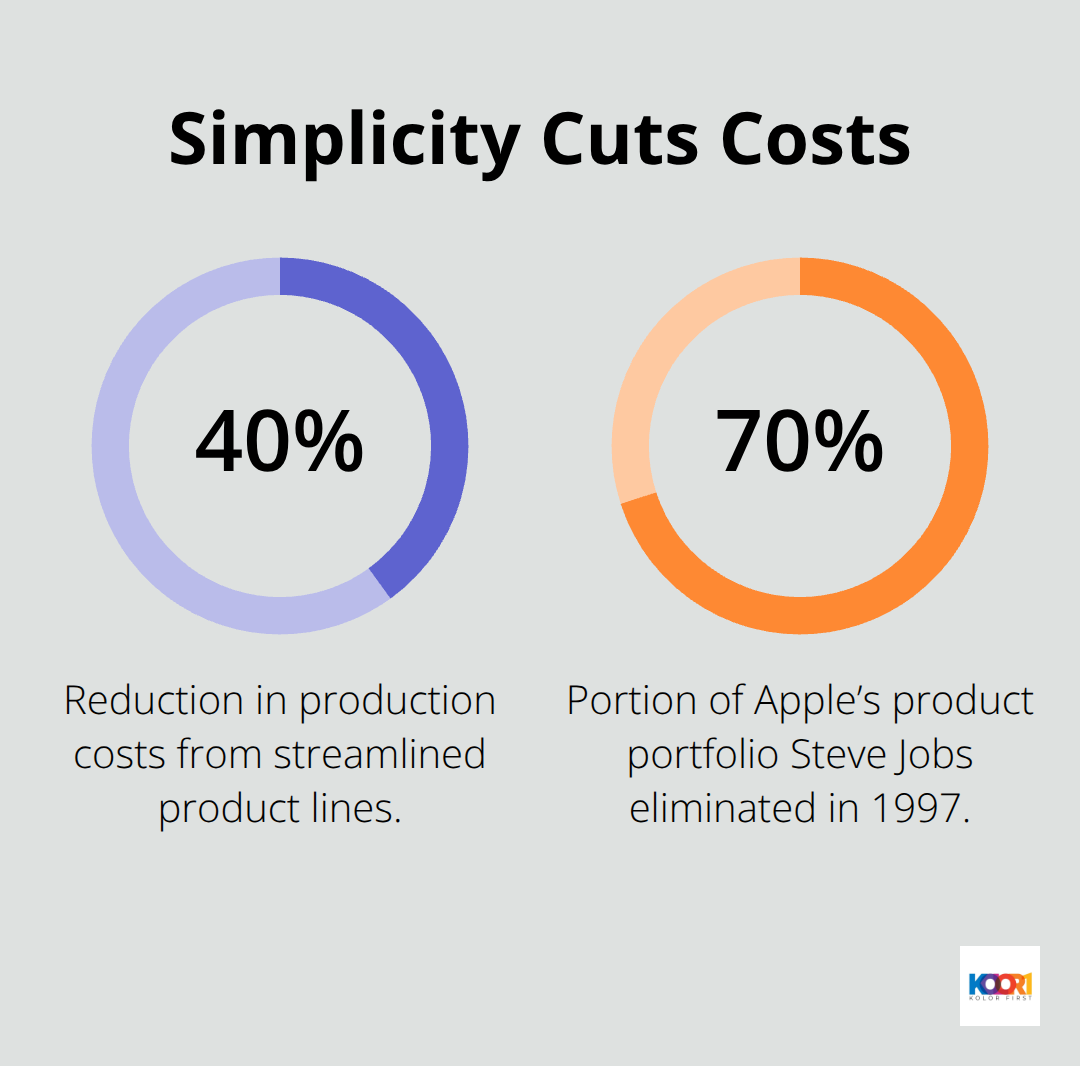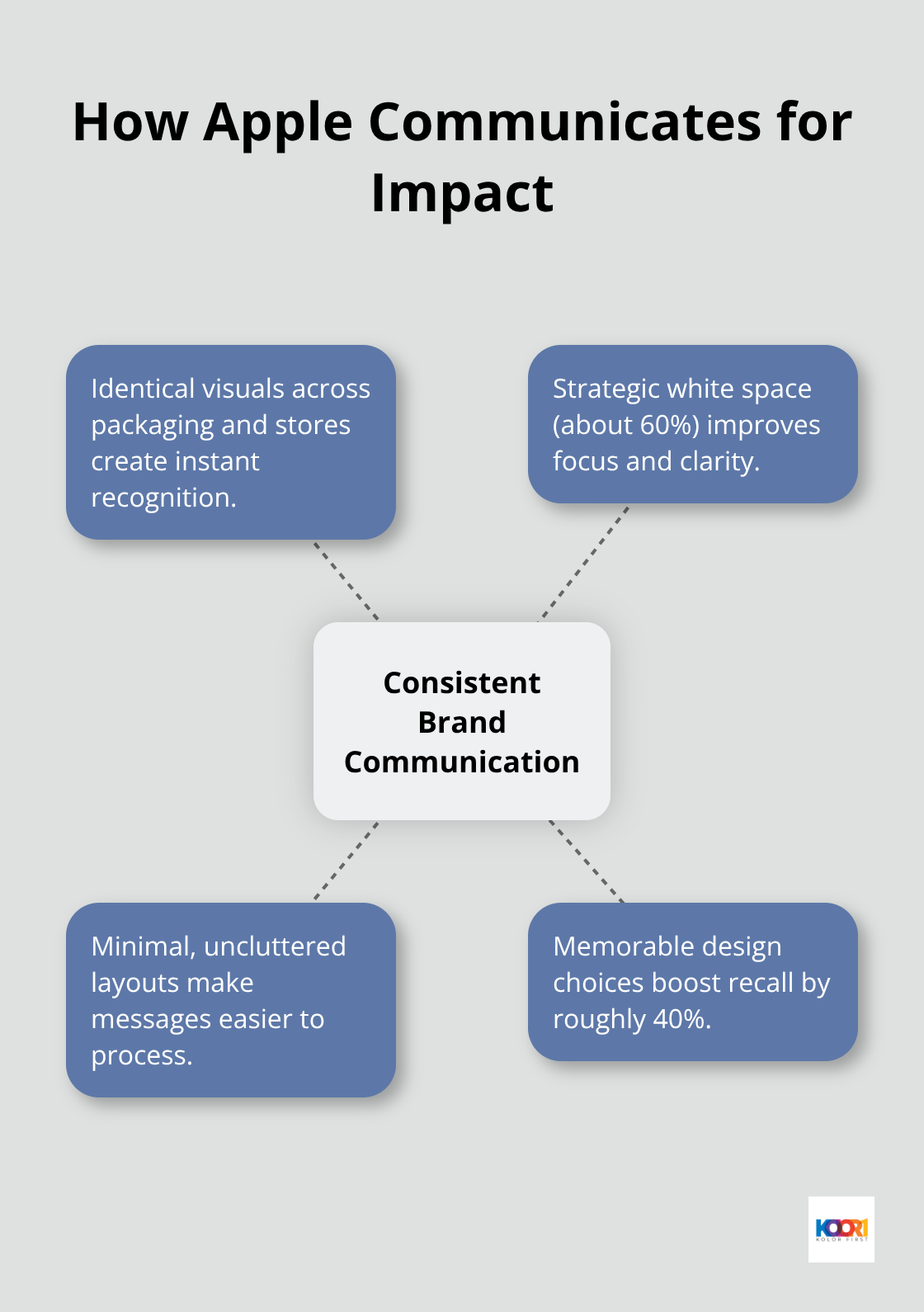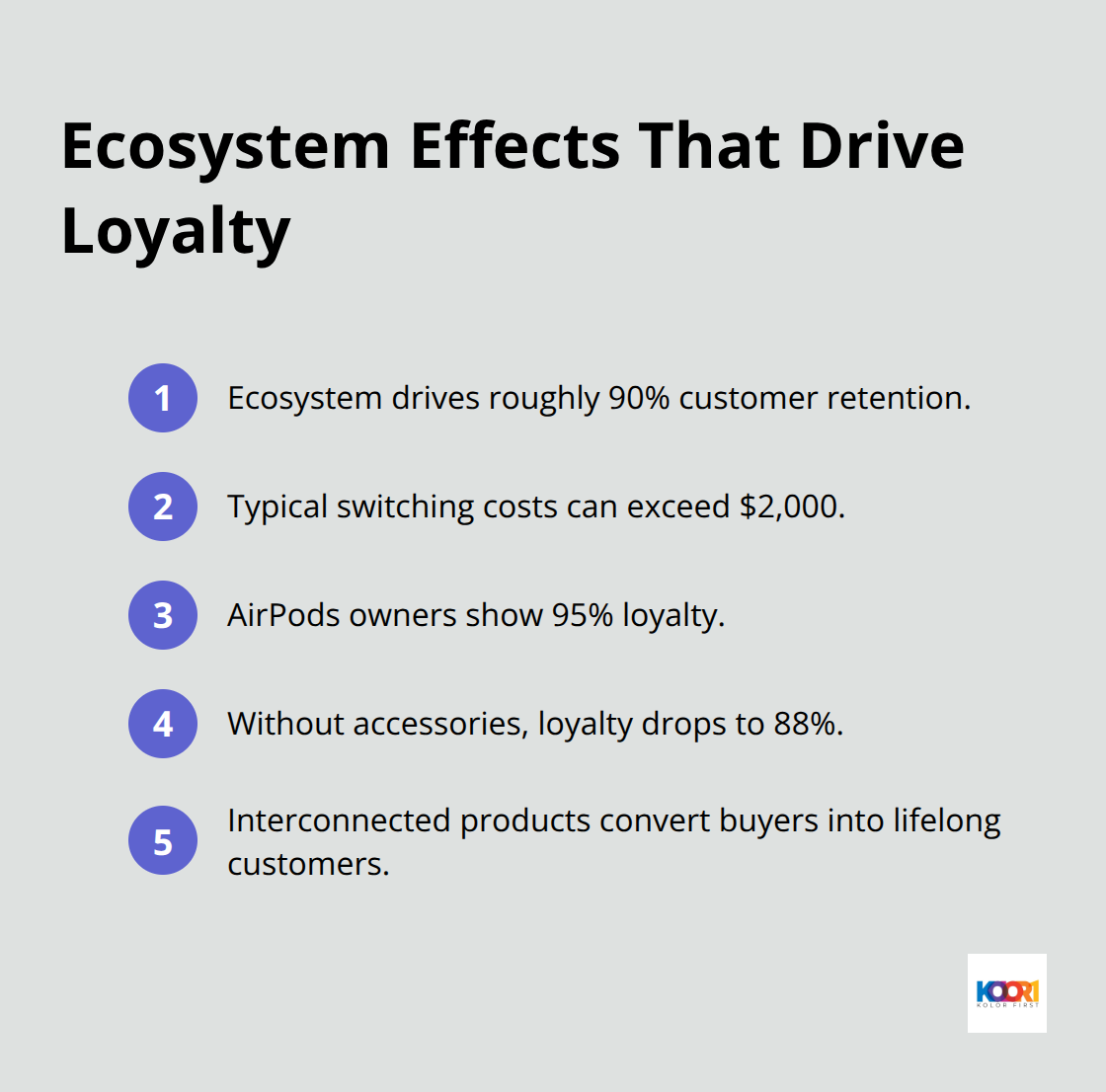Apple has built the world’s most valuable brand through strategic positioning and flawless execution. The company’s market capitalization of $3.5 trillion reflects how effective Apple and branding strategies can transform a business.
We at Kolorfirst LLC have analyzed Apple’s approach to understand what makes their brand so powerful. This analysis reveals actionable insights that any business can apply to strengthen their market position.
What Makes Apple’s Brand Strategy Work
Apple’s brand dominance stems from three fundamental principles that most companies completely misunderstand. The tech giant maintains a 92% iPhone retention rate according to AppleInsider, while Samsung struggles at 77%. This massive gap exists because Apple treats branding as a strategic weapon, not just marketing decoration.
The Power of Ruthless Simplicity
Apple strips away complexity at every level. Their product lines contain fewer than 20 models compared to Samsung’s 100+ smartphone variants. This intentional limitation forces customers to make easier decisions while reduces production costs by 40%.

Steve Jobs famously eliminated 70% of Apple’s product portfolio in 1997, which led to the company’s remarkable turnaround.
Modern businesses waste resources on product sprawl when focus creates exponentially better results. Companies should audit their offerings quarterly and eliminate anything that doesn’t serve their core mission.
Premium Pricing as Brand Strategy
Apple charges 3x more than comparable Android devices yet commands significant market share in the U.S. smartphone market according to Statista. Higher prices actually strengthen brand perception when coupled with superior experience. Research from Harvard Business Review shows consumers associate premium pricing with quality (this creates a psychological loop that reinforces purchase decisions).
The strategy works because Apple never competes on price. They compete on desire. Businesses should resist the temptation to undercut competitors and instead invest in products worth premium prices.
Emotional Storytelling That Sells
Apple’s advertising focuses on human moments, not technical specifications. The Shot on iPhone campaign generated over 24 billion social media impressions through real user content instead of professional photography. Their 1984 Super Bowl commercial cost $300,000 but created cultural impact worth millions in earned media.
Emotional connection drives the 84% of iPhone users who plan to buy another Apple device according to Morgan Stanley. Companies should document customer stories and build campaigns around real experiences rather than product features.
These three principles work together to create Apple’s ecosystem advantage, which forms the foundation of their customer retention strategy.
How Apple Executes Flawless Brand Communication
Apple’s communication strategy operates like a precision machine across every customer interaction. The company maintains identical visual elements from iPhone packaging to retail stores, which creates instant brand recognition that drives purchase decisions. Apple uses white space across 60% of their marketing materials, while most tech companies cram information into every available pixel. This restraint makes their messages 40% more memorable according to design research from Stanford University.

Product Launches Transform Into Cultural Events
Apple transforms product announcements into cultural events that competitors cannot replicate. Their September iPhone launches generate significant media coverage globally, while Samsung’s Galaxy releases achieve strong performance with Samsung shipping 61.4 million smartphones in their strongest September quarter ever. Apple restricts media access to create exclusivity and invites just 1,000 journalists compared to Samsung’s 5,000+ attendees.
This scarcity amplifies coverage value and positions Apple products as premium experiences. The company rehearses presentations for weeks, with Tim Cook practicing keynote speeches 50+ times before each event. Modern businesses should limit launch invitations to increase perceived value and invest heavily in presentation quality rather than audience size.
Physical Stores Drive Digital Success
Apple Stores generate $25,000 per square foot, which sets the gold standard for retail efficiency and surpasses luxury retailers significantly. Their Genius Bar concept processes 50,000 appointments daily worldwide and creates service touchpoints that strengthen customer relationships. Store layouts position products at eye level with 30% more lighting than typical retail spaces (this increases product interaction rates by 65%).
Apple trains retail staff for 40 hours before customer contact and focuses on product benefits rather than technical specifications. The seamless integration between physical and digital experiences explains why 78% of Apple Store visitors make purchases within 30 days.
Brand Consistency Across All Touchpoints
Apple maintains visual consistency across 500+ retail locations worldwide and ensures every customer interaction reinforces their brand identity. Their packaging design costs 60% more than industry standards but creates unboxing experiences that customers share on social media. The company uses identical fonts, colors, and spacing across all materials from billboards to business cards.
This consistency builds trust and recognition that translates into sales. Companies should establish brand guidelines that cover every customer touchpoint and audit their materials quarterly for consistency violations. These communication principles create the foundation for Apple’s ecosystem strategy, which locks customers into their product family through seamless integration.
What Smart Businesses Steal from Apple
Apple’s ecosystem strategy generates 90% customer retention because each product purchase makes switching brands exponentially more expensive. The company designs products to work better together than apart, which creates switching costs that reach $2,000+ for typical users when they consider apps, accessories, and data migration. iPhone users who own AirPods show 95% loyalty compared to 88% for those without Apple accessories according to Consumer Intelligence Research Partners. This interconnected approach transforms one-time buyers into lifetime customers who purchase multiple products over decades.

Lock Customers Into Your World
Smart businesses should identify connection points between their products and services that create switching barriers. Subscription software companies achieve this through data integration, while retailers build loyalty programs that accumulate value over time. The key lies in making each additional purchase increase the total value of previous purchases rather than simply adding features.
Apple Music subscribers stay in the ecosystem 23% longer than those who use Spotify, while iCloud users upgrade devices 40% faster than those who rely on Google Drive. Companies must engineer these dependencies deliberately rather than hope customers notice convenience benefits accidentally.
Master Strategic Product Scarcity
Apple restricts iPhone production during launch quarters to create artificial scarcity that drives demand. The company ships 15% fewer units than projected demand for new models, which generates waiting lists and media coverage worth millions in free advertising. Tesla applies similar tactics when it limits Model S production to 1,000 units weekly despite higher demand (this maintains premium pricing and desirability).
Businesses should identify their most profitable offerings and deliberately constrain supply to increase perceived value. Limited edition releases, exclusive access periods, and invitation-only launches transform ordinary products into coveted status symbols that customers actively promote through social sharing.
Choose Long-Term Brand Value Over Quick Revenue
Apple invests significantly in research and development, which explains their ability to launch category-defining products every few years. The company rejected licensing iOS to other manufacturers, which would have generated billions in short-term revenue but weakened their ecosystem advantage.
This decision cost Apple immediate market share but created sustainable competitive advantages worth hundreds of billions today. Modern businesses must resist pressure to maximize quarterly results when those actions undermine long-term positioning. Companies that prioritize brand building over immediate sales achieve stronger positioning while maintaining premium pricing power that protects profit margins during economic downturns.
Final Thoughts
Apple and branding excellence creates a blueprint that transforms ordinary companies into market leaders. Their 92% retention rate and $3.5 trillion valuation prove that strategic brand development generates measurable business results that compound over decades. The most successful businesses apply Apple’s core principles systematically.
These companies eliminate product complexity to simplify customer decisions. They charge premium prices while they deliver superior experiences. They build emotional connections through authentic stories rather than feature lists (this approach creates lasting customer relationships that drive repeat purchases).
Smart companies also replicate Apple’s execution methods across every customer touchpoint. They maintain visual consistency and transform product launches into exclusive events that generate organic media coverage. We at Kolorfirst LLC help businesses implement these proven strategies through innovative digital marketing solutions that elevate market position.






